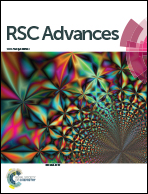Experimental and computational exploration of the UV-visible properties of hexaniobate and hexatantalate ions†
Abstract
The UV-visible properties of hexaniobate (HxNb6O19x−8) and hexatantalate (HxTa6O19x−8) ions were investigated experimentally and by DFT calculations. Due to the huge discrepancies among the reported values found in prior studies, the extinction coefficients of hexaniobate ions were determined from multiple samples in various media. A simple and low-cost method was then developed for the determination of the niobium content of both synthetic and industrial samples. Taking advantage of the UV spectra of the hexaniobate ions, the first protonation constant of Nb6O198− could be determined experimentally (pKa = 13.4 ± 0.1 at 25 °C, ΔrH = −95 kJ mol−1 in 3 M KOH/KCl) and is in accordance with the reported values previously extrapolated from potentiometric measurements (pKa = 13.3 ± 0.6). UV batch titrations performed at different ionic strengths suggest that the equilibrium between the monoprotonated and the deprotonated forms of the Lindqvist ion is accompanied by an exchange of potassium ions and that the cluster is easier to deprotonate in Na+ media. This study highlights the importance of the ion-pairing on the chemistry of these polyoxometalates. The tremendous difference between the UV spectrum of Nb6O198− and Ta6O198− was investigated by DFT computations. The UV spectra were reproduced and show a good agreement with the experimental data. Moreover this study revealed some insights into the evolution of the spectra together with the pH of the medium by studying the nature of the transitions involved in this spectral domain.


 Please wait while we load your content...
Please wait while we load your content...